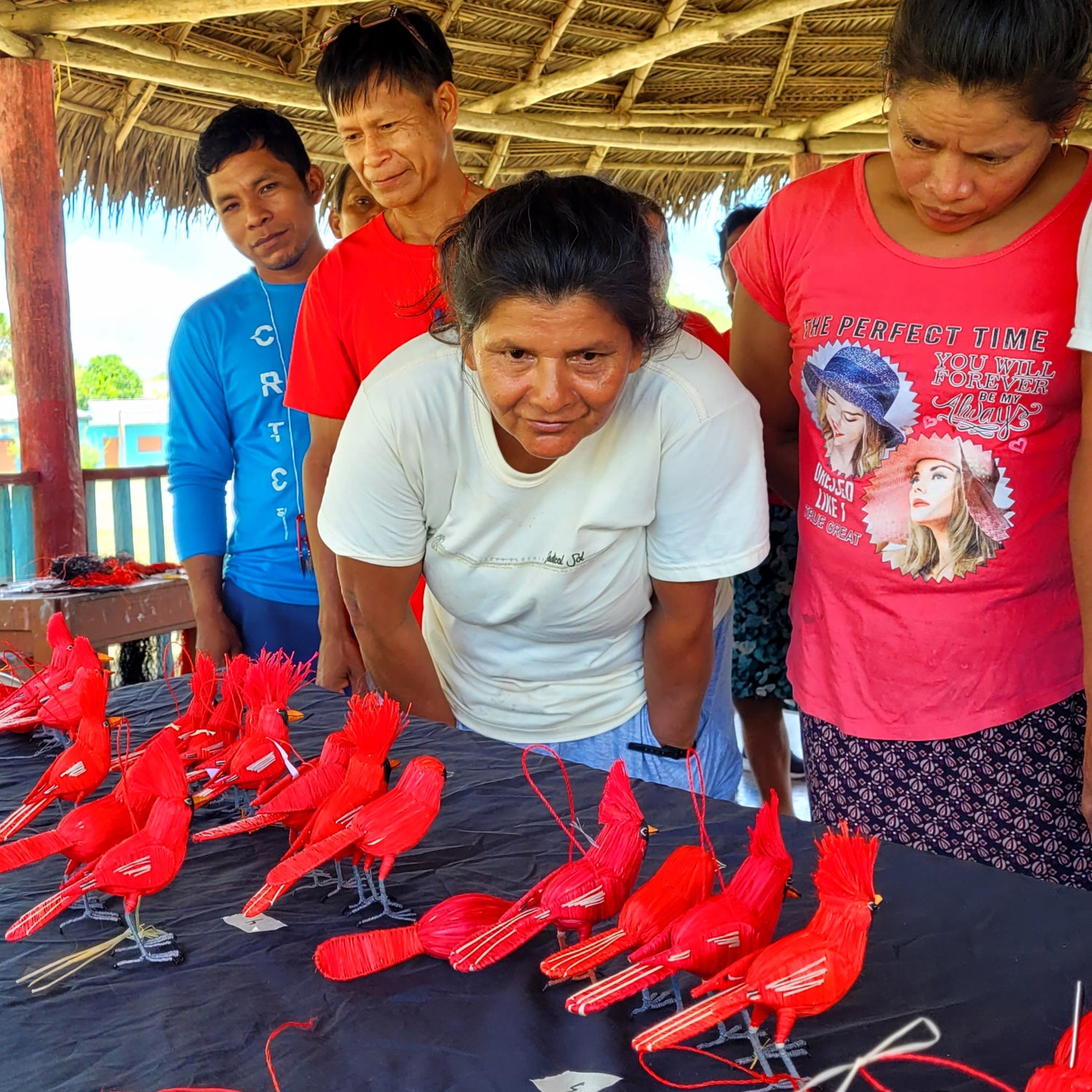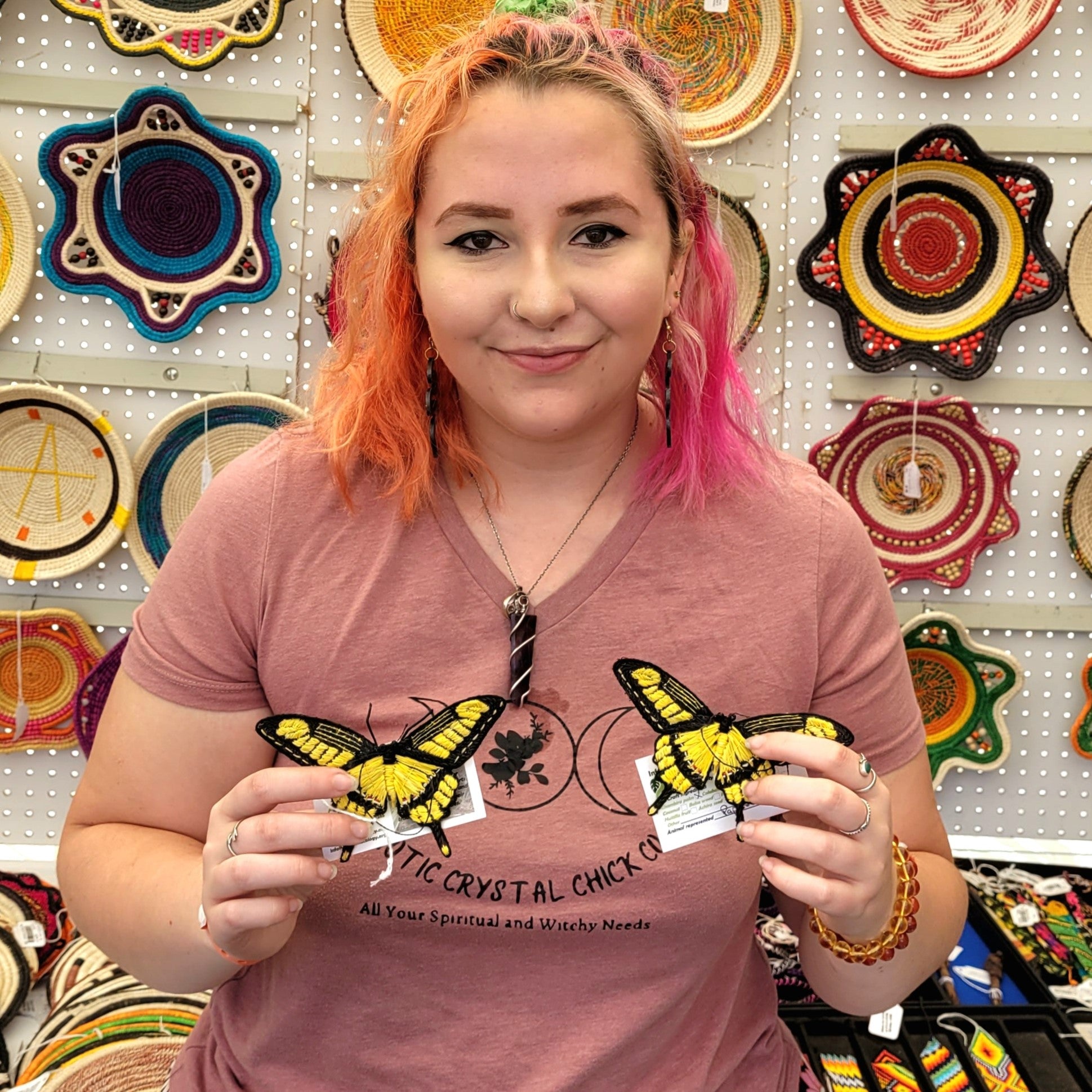Summary
I spent five weeks in the Peruvian Amazon between Feb. 13 and March 20, 2023 to help facilitate and support diverse capacity building activities in traditional forest communities in the northern Peruvian Amazon organized by the non-profit group Amazon Ecology. These activities included one Basic level Artisan Training workshop, two Guided (Advanced) Artisan Workshops, one Training for Artisan Facilitators workshop, and two introductory sessions to the Alternatives to Violence Program (AVP). Apart from these scheduled activities, I also had meetings with five other groups of artisans and arranged for a woman’s health specialist to visit one of our partner communities. These activities and their impact are described in more detail below.
Artisan Facilitator Workshop in Amazonas (Feb. 16-19)
This workshop brought together 22 artisans from 6 communities from the Marañon, Ampiyacu, Ucayali, and Tahuayo River regions for four days to develop their skills as artisan facilitators. The participants were placed in four groups of five or six people for most of the activities. Each group was tasked with making two different woven bird ornaments in the first three and a half days. The species made were the northern cardinal, peregrine falcon, ornate hawk eagle and harpy eagle. One member of each group played the role of facilitator for 20 minutes before this duty was passed on to another member.
The main task of the facilitator was to go from person to person in their group and carry out the five steps of our facilitator protocol. These are: explain (with words), show (with actions), observe (with eyes), feedback (detailed and constructive suggestions with words and actions), and affirm (with words and gestures). At the end of every morning or afternoon session, one person from each small group needed to give a brief presentation to the large group about something they did or learned.
One new technique that we incorporated into the ornament making process were making wire templates for the head, body, wings and tail for each species so each kind of bird could be made with the same dimensions. We also introduced a modified assembly line process so each artisan in a group would take responsibility for making five sets of each part. Once these parts were put together, each artisan would add the details to their bird. These two innovations allowed the groups to make their birds with higher quality and consistency in much less time than when they worked by themselves. In the final day of the workshop, we mixed up the groups and challenged them to make their choice of a poison arrow frog or a lady bug.
My main roles in this workshop were helping design, guide, and animate the process. I loved walking around taking photos of people working intently on their birds and literally putting their heads and hands together to express and share their creativity. The final evaluation was very gratifying as participants shared things they appreciated about the workshop. Their comments included: becoming more comfortable speaking in public, sharpening their eyes to recognize the minor details that distinguish a good (or bad) craft from a great one, improving their craft making by observing, offering and receiving suggestions from fellow artisans, and understanding that patience, generosity, and openness to mutual learning are more important qualities of a good facilitator than being “an expert.”
Basic artisan workshop in Brillo Nuevo and other meetings in the Ampiyacu (Feb. 23-28)
The artisan workshop in Brillo Nuevo was considered a “basic” one because we provided full support (i.e. meals and transportation) for the participants to attend. In practical terms, it was really a four-day long advanced level training since most of the artisans had already made a woven animal ornament before. They did very well learning to make the pink flamingo and the blue jay which were both new and complicated species. The participants were guided by one of our most experienced artisan facilitators with assistance each day from a different apprentice facilitator who had just attended our facilitator training in Amazonas. It was great to see these artisans gaining confidence in their craft-making skills and articulating their pride in being an artisan.
I was a bit sick for a couple of days during this workshop so my role was limited to occasionally taking photos of people in the workshop and displaying their crafts at the end of it. While resting in our house, I was glad to have the company of a small (and very skinny) dog who gratefully accepted my food leftovers and some pets. More exciting one afternoon was having an anxious colleague warn me not to move when she came to the door and saw a snake crawling under my hammock. She beckoned one of our artisan friends who quickly came and captured the wandering reptile which fortunately was not venomous.
We had a very good discussion with a young and talent painter from the village about leading a workshop that would bring community members together to discuss problems related to the theft of chambira palm leaves which are the most important raw material for making woven crafts and use an artistic medium for people to show the importance of chambira palm trees in their cultural and economic lives. The original concept was to coordinate a group mural project on the wall of the elementary school, but we have now received special funding to have the participants create montages with the same themes which could be used in moveable displays.
On our way downriver from Brillo Nuevo, we stopped in Nuevo Peru to do an introduction to the Alternatives to Violence Project (AVP). This three-hour session provided attendees with an experiential taste of a Basic AVP workshop with a brief explanation about its history, philosophy and examples of its listening exercises and fun bonding (“light and lively”) activities. I always enjoy seeing how these activities always seem to resonate with people in any culture.
While AVP workshops often bring strangers together, it was equally rewarding to hear these people appreciate how this process allowed them to share things on a personal level in ways they never had with people they had known their whole lives. Men who would often be too reserved to act in ways that might be considered “silly” were gleefully playing games like “holes and armadillos” (an Amazon adaptation of “landlords and tenants”). We concluded by explaining the commitment needed to organize a full Basic AVP workshop and the other workshops involved in the full series. If there is sufficient interest, we will seek support to host this.
One other joyful task during this trip was delivering two portable oxygen generators to both government health posts in Puca Urquillo and Brillo Nuevo. A major Peruvian equipment importer donated seven of these machines to us at the end of 2022 to pass along to communities who could really use them. While these machines were brought to Peru to help people in the peak of the pandemic, the health post coordinators were very happy to receive this equipment since it will help them treat adults with severe respiratory conditions or use as a nebulizer for children.
At the end of this Ampiyacu trip, we met with our regular artisan partners from Puca Urquillo Bora and Puca Urquillo Huitoto to buy some woven bags and bottle carriers and encouraged them to participate more fully in our ornament-making workshops since this is the best way we could help them significantly increase their craft sales.
Our third meeting was an evening gathering with native artisans living in the Sargento Lores neighborhood of the town of Pebas. Most of these women had all moved from various Bora communities to town with their families over the past ten years so their children could attend its secondary school. They and another 25 artisans from the area had all signed up to be members of an artisan association whose founder never got them organized. We told them we would gladly host a training workshop for them to learn to make the ornaments and help them formalize their own group whenever they felt ready to do so.
Guided artisan workshop in Esperanza and other activities along the Tahuayo River (March 2-7)
I have enjoyed a cordial welcome from the artisans from the campesino community of Chino since we first visited them in 2008. I admired that this group had a functioning artisan association and commitment to chambira palm management far longer than any other group we work with. I was also happy that we were able to buy and sell a fair number of woven baskets, frogs and some other crafts and reinvest part of these sales to support the Chino school and other community needs in various ways.
When we started doing regular workshops about five years ago, however, to teach artisans how to make new animal ornaments, improve their marketing skills and engage with AVP workshops, most of them lacked enthusiasm for these activities and they ultimately said they did not want to participate in them. While they very much welcomed selling crafts to us at times, their interest in doing so has consistently waned when there is a good flux of tourists visiting their community from a nearby eco-tourism lodge.
I visited this community again for half a day during this trip to buy some new crafts from their artisans at an open fair and placed a small order for some new crafts. I felt a renewed bout of sadness during this visit since it was apparent that in spite of some genuine mutual affection that I believe exists between these artisans and me, they do not want to take advantage of the opportunities we can offer and the increased prices they are charging for their current products will severely limit our ability to buy many of the products which they most want to keep making.
So as it feels like way is closing or at least declining in our dealings with Chino, doors have now been opening with two of Chino’s neighbors on the Tahuayo River. Esperanza is the largest village along the river and had a very active group of artisans which fifteen years ago was the focal point of a multi-community enterprise which was exporting 700-800 baskets to the US every three to four months. Various changes with the supply of chambira, quality control, transport logistics, and market demand, however, brought this booming business down to a trickle of sales to a few stores in Lima without any option to sell directly to tourists. It only took one introductory meeting with the Esperanza artisans last fall to organize a Basic artisan workshop with them in January which we followed up with an advanced “Guided” workshop during my visit there in early April.
Our lead facilitator Pablo was particularly impressed with the rapid progress these experienced artisans made learning to make woven birds. It was clear they were both able and willing to apply the skills they had developed to make the most precise and elegant baskets in the region to the need for attention to very small details in making high-quality animal ornaments.
Our optimism for the future of working with this group was further augmented by the enthusiastic participation of two of their members as apprentice facilitators in this workshop who had attended our Artisan Facilitator training the month before. One of these displayed her initiative by making several new versions of a lady bug ornament that she had first made in the experimental section of the facilitator workshop. It was also encouraging she willingly absorbed our detailed feedback so she could improve these draft models and make a prototype for a trial order.
We told the artisans a bit about AVP during the workshop, and they expressed enough interest for us to organize an impromptu introduction to AVP one evening. I was a bit concerned the session started late, the lighting was poor, and the seating was limited to some rickety wooden benches and school desks positioned to avoid water dripping from a leaky roof. When we reached critical mass, though, some doubtful faces and dour demeanors transitioned to deep conversations, gentle eyes, wide smiles and playful laughter. I felt joy and some pride that I played a role in allowing AVP to work its magic for energizing our internal light that attracts people to each other.
Apart from my other favorite activity of taking pictures of yellow-rumped caçiques darting in and out of their colony of long hanging nests with their melodious chirps, it was great to be able to present another oxygen concentrator to the director of the health post in Esperanza. This is a critical nexus for health care in the region since it serves 17 different villages in the Tahuayo and Tamshiyacu River basin.
We made one quick stop in the village of Santa Cruz during our trip to the Tahuayo. Most people were involved in a meeting in the church, but we had enough contact with a few artisans to confirm that they were interested in filling an order for more colored fans made with chambira leaf material and that they wanted to have their own guided workshop to advance their own bird ornament making skills. This workshop is now scheduled to happen in June.
Guided workshop for artisans and support for young women in Amazonas (March 11-14)
The final workshop I attended during this trip was a four-day long guided workshop held in the round community gathering space in Amazonas. This included artisans from the host village, San Francisco and Puerto Miguel – a community on the Ucayali River. As with other workshops held during this trip, the experienced artisans worked in small groups using the wire templates and modified assembly process to make blue jay and pileated woodpecker ornaments with chambira palm fiber.
On the last day of the workshop, we invited participants to display other crafts for sale in an open “feria” in open-walled structure with tables normally used to welcome tourist visitors to the community. We bought some of these diverse crafts to sell in the US and our store in the city of Iquitos, but these purchases were modest since the quality of most of them was mediocre in comparison to the export-quality crafts being made by the artisans in the workshop fifty feet away.
This experience was a potent reminder to us and the artisans that they can make really nice crafts with proper encouragement and compensation. We also had to accept that many artisans are content to keep making lower-quality crafts because they take less time and they are often able to easily sell them to tourists who are often less discriminating in their purchase of souvenirs. We were happy, however, that there was a growing cadre of artisans who were taking pride in making high-quality crafts with the knowledge that this will give them larger and more stable income selling crafts to Amazon Ecology and other wholesale customers.
The other special part of this visit was bringing a new friend Dana Babbit to the community. Dana is a retired school teacher from Oregon who regularly comes to Peru as a volunteer to help an Iquitos public school improve access to information and learning tools through small but powerful little computers. She also leads presentations to help girls in poor communities understand and better manage menstruation.
We invited all of the artisans from the communities, their daughters and other interested people to come to the artisan leader Francisca’s house after the workshop to view the educational video “Hola Menstruación (“Hello Menstruation”) that clearly explains what this natural part of a female’s life is about and how a young woman can manage it without embarrassment.
Dana also handed out about forty Days for Girls kits put together by volunteer women’s groups in the US. Each kit contains hand-sewn reusable pads and other supplies so low-income young (and older) women can meet their sanitary needs during their periods without needing to buy expensive one-time use pads. Francisca’s house and porch area was packed, and Dana wrote down names of 40 more women who would like to receive the Days for Girls kits. While I have tried to support health care in our community partners from the beginning, I had not been aware of this aspect of women’s health which has important emotional, economic and social dimensions. I look forward to working with Dana to help meet a need where relatively few resources can make a big difference.
Acknowledgements
I wish to thank the following organizations for their financial support for this trip and the activities carried out during it.
New England Biolabs Foundation
Philadelphia Yearly Meeting - Travel Witness Grant
North Central Pennsylvania Alternatives to Violence Project
donors to Amazon Ecology through Global Giving




